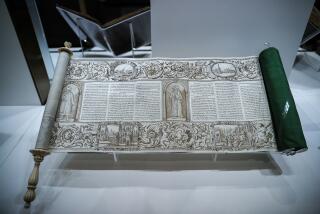So long ago, so very much like us
Eight eloquent papyrus scrolls are at the heart of âJewish Life in Ancient Egypt: A Family Archive from the Nile Valley,â an exhibition now at the Skirball Cultural Center.
Written in Aramaic, resurrected by Mel Gibson for âThe Passion of the Christâ but very much alive in the 5th century BC, the scrolls chronicle landmark moments in the lives of a Jewish temple official and his Egyptian wife as they marry, raise children, buy and renovate a house and go about their daily business in a multicultural community near what is now Aswan.
âThe storyâs so compelling because these people are so much like us,â said curator Edward Bleiberg of the Brooklyn Museum of Art, where it opened in February 2002.
Bleiberg recalled the shock of recognition when he first read the text of the scrolls in translation. Discovered in 1893 on the Nileâs Elephantine Island, the scrolls include the marriage contract of Ananiah and wife Tamut, the document freeing Tamut from slavery and the details of a loan of a large amount of wheat. But the papyri dealt mostly with real estate, beginning with Ananiahâs purchase of a 750-square-foot house from a Persian soldier.
âAs I read I began to feel this strange connection with them,â Bleiberg said. The curator and his wife had just moved to New York City from Memphis, Tenn., âand real estate, the great obsession of every New Yorker, was our obsession.â
Bleiberg was still reeling from the discovery that he would get half the house for twice the price in New York when he began reading about Ananiah and Tamutâs two-story fixer-upper: âOur apartment is about the same size as the house this couple bought,â Bleiberg said.
Unlike the scrolls, some 60 other objects in the show are vivid reminders that these lives began and ended some 2,500 years ago. A sparkling gold coin bears the fiercely handsome face of Alexander the Great, who conquered Egypt 70 years after the last of the papyri was written, rolled and sealed.
But the documents illuminate 47 years in the lives of an ancient couple whose preoccupations could be our own. Sounding like a modern prenuptial agreement, a section of their marriage contract spells out who gives up what should the union end, depending on who leaves whom. The document relating to the sale of the house includes the sellerâs promise not to sue the buyer. A later scroll transfers title of the house to Ananiah and Tamutâs daughter and son-in-law, with the proviso that they care for her aging parents.
Like the Jewish Bleibergâs own marriage (his wife grew up Methodist in Vidalia, Ga.), Ananiah and Tamutâs was an intercultural affair. He was one of many Jews living in Egypt 800 years after the Exodus, she was the Egyptian slave of a Jewish owner, who signed her marriage contract in her fatherâs stead. Tamut had probably been sold into slavery as a child, to pay her fatherâs debts, Bleiberg speculated.
The document freeing Tamut must have been especially precious to the family. When she became a slave, her hand was tattooed, branding her as the property of her master. The tattoo would remain forever but, after June 12, 427 BC, she had a scroll proving she was free.
The neighborhood where the ancient couple lived was no Jewish ghetto. It included Persians and Egyptians as well as Jews, all apparently living together in relative peace near the islandâs Jewish temple. That, too, reminded Bleiberg of his Brooklyn neighborhood. At his ATM, he said, bank customers are asked the language they prefer for their transactions -- and they have a choice of eight.
The papyri were among some 12,000 Egyptian artifacts in storage at the Brooklyn Museum of Art, and Bleiberg proposed building a show around them in response to the museum directorâs mandate to âmine the storerooms for new exhibitions.â
The challenge was fleshing out the visually nondescript scrolls with evocative objects. As in most periods in history, Bleiberg said: âJews left us lots of words but not very many art objects.â
Bleiberg unearthed dozens of resonant items from ancient Egypt, Persia and the Hellenistic world that help place the human story in historical context. Thirty objects from the Brooklyn show are augmented by 30 or so from the collections of the Skirball and USC.
The distinctive faces of the racially and ethnically diverse soldiers of King Ahkenaten or Tutankhamen are recognizable on a limestone relief from the 14th century BC. A statue shows how Egyptian scribes sat, holding papyrus scrolls. An ancient kit shows the tools of the scribesâ trade, with an indentation on top for ink and a covered compartment for reed pens.
In the temple where Ananiah worked, perhaps caring for the building, Jews practiced an unorthodox form of Judaism. Although they sacrificed rams like others of their faith, they also hedged their bets on monotheism, burning incense to other gods and offering cakes to the Queen of Heaven.
The local show includes three goddess figures from the period -- statuettes of female deities with torpedo-like breasts suggestive of fertility.
Such pagan practices horrified the prophet Jeremiah, as recorded in the Books of Kings and Jeremiah. But there is evidence that the ancient Jews of Elephantine celebrated something very much like Passover, called the Feast of Matzoh, and observed the Sabbath. Or at least they knew what the Sabbath was, even if they didnât always keep it.
Bleiberg cites a scroll from Elephantine now in Berlin in which a merchant writes to an agent: âI am sending you a load of goods. I donât care, even if it arrives on Shabbos, unload it.â
*
âJewish Life in Ancient Egyptâ
Where: Skirball Cultural Center, 2701 N. Sepulveda Blvd., L.A.
When: Tuesdays-Saturdays, noon-5 p.m.; Sundays, 11 a.m.-5 p.m.
Ends: July 18
Price: $6-$8
Contact: (310) 440-4500
More to Read
The biggest entertainment stories
Get our big stories about Hollywood, film, television, music, arts, culture and more right in your inbox as soon as they publish.
You may occasionally receive promotional content from the Los Angeles Times.










